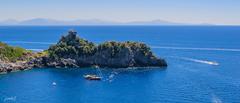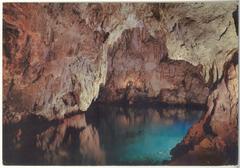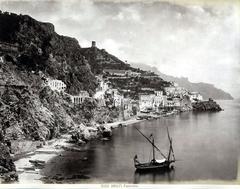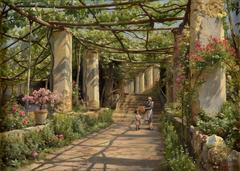Museo La Valle Dei Mulini: Visiting Hours, Tickets, and Amalfi Historical Sites Guide
Date: 14/06/2025
Introduction
Nestled above the picturesque town of Amalfi, the Valle dei Mulini (Valley of the Mills) and its celebrated Museo La Valle Dei Mulini offer a captivating journey through centuries of industrial ingenuity, natural beauty, and cultural tradition. Once the bustling heart of Amalfi’s world-renowned papermaking industry, this lush ravine is now an evocative destination for travelers interested in history, artisanal crafts, and the unique ecology of the Amalfi Coast. This guide provides comprehensive details on the valley’s geological origins, its industrial and cultural significance, visiting hours, ticketing, accessibility, guided tours, hiking, and nearby historical sites.
For current details and enriching resources, consult the Museo della Carta website, and explore further through trusted sources (Ancient Origins, Authentic Amalfi Coast, Italy Magazine).
Historical Overview
Geological Origins and Early Settlement
The Valle dei Mulini is a dramatic limestone ravine formed by ancient volcanic activity and further sculpted by the Canneto River over millennia (Ancient Origins). Its abundant water supply made it ideal for water-powered industries, prompting settlement as early as the 10th century CE. The valley’s natural resources and unique microclimate enabled the development of sophisticated papermaking and milling operations.
Medieval Flourishing: The Rise of Papermaking
By the 13th century, the valley was a thriving industrial center, with the introduction of papermaking techniques by Arab traders, later perfected by the Amalfitans (Costiera Amalfitana; Amalfi Paper Museum). The mills produced “carta bambagina,” a prized cotton-based paper. At its peak in the 18th century, up to 16 mills operated here, exporting paper across Europe.
Economic and Cultural Impact
Amalfi’s papermaking brought economic prosperity and cultural prestige. The “Congrega dei Cartari,” a papermakers’ guild, regulated production and maintained quality standards (Authentic Amalfi Coast). Amalfi paper was favored by scholars and nobility, its quality rooted in unique techniques and local materials (Costiera Amalfitana).
Decline and Nature’s Reclamation
Industrialization, climate challenges, and catastrophic floods (notably in 1954) led to the decline and eventual abandonment of most mills by the early 20th century. The valley’s ruins became enveloped in lush vegetation, transforming into a natural sanctuary within the Monti Lattari Regional Park (Italy Magazine).
Visiting Valle dei Mulini and the Museo della Carta
Location and Access
The Museo della Carta is located on Via delle Cartiere, a 10–15 minute walk from Amalfi’s main square, tracing the Canneto stream. The path is gently inclined and well-signposted, making it accessible for most visitors.
Address:
Via delle Cartiere, 84011 Amalfi (SA), Italy
Coordinates: 40.6341° N, 14.6020° E
Opening Hours
- Museo della Carta: Open daily from 10:00 AM to 6:00 PM, with last entry at 5:15 PM (Museo della Carta Official).
- Valle dei Mulini hiking trails: Open year-round, accessible during daylight hours.
Tickets and Admission
-
Museo della Carta:
- Adults: €5
- Children (6–14): €3
- Family/group rates available
- Guided tours: +€3 per person (multi-language options)
-
Valle dei Mulini trails: Free access (aziendaturismopositano.it).
Getting There
- By Bus: SITA buses connect Amalfi with Positano, Ravello, Sorrento.
- By Ferry: Summer ferries run from Positano and Salerno.
- By Car/Scooter: Limited parking; public transport is recommended.
The Museo della Carta: A Living Tradition
Museum Experience
Housed in a restored 14th-century paper mill, the Museo della Carta offers immersive guided tours (in Italian and English), live papermaking demonstrations, and thematic exhibits. Knowledgeable guides, often descendants of local papermakers, explain the machinery and historical context. Visitors can participate in hands-on workshops, including papermaking, calligraphy, and bookbinding (Museo della Carta Visitor Info).
Key Features:
- Restored water wheel and millrace
- Original pulping hammers and presses
- Thematic rooms (rag room, vat room, printing room, archive)
- Temporary exhibitions and educational activities (Amalfi Coast Official Tourism)
Accessibility: The museum is partially accessible; historic architecture may pose challenges for those with limited mobility (Tripadvisor Reviews).
Facilities
- Restrooms near entrance
- Gift shop with handmade Amalfi paper and local souvenirs
- Multilingual information panels and audio guides
Hiking and Nature in Valle dei Mulini
Hiking Trails
The valley features scenic trails of varying difficulty, suitable for families and experienced hikers alike:
- Lower Circuit: 3 km, moderate elevation, 1.5–2 hours; ideal for most visitors (AmalFeet).
- Upper Circuit: Full-day, challenging; panoramic views for experienced hikers (Italy Adventure).
Highlights:
- Mossy mill ruins
- Canneto River waterfalls
- Lemon groves and terraced vineyards
- Rare flora such as Woodwardia radicans
Guided Tours
Expert-led walking tours provide historical and ecological insights. Tours can be reserved online; prices start around €58 per person for full-day experiences (Italy Adventure).
Nearby Historical Sites and Attractions
- Amalfi Cathedral (Duomo): Ornate 9th-century church, 1.6 km from the museum.
- Valle delle Ferriere: Nature reserve with rare plants, waterfalls, and scenic hiking (2.2 km from museum).
- Ravello: Hilltop town with historic villas and panoramic terraces (7.4 km).
- Terrazza dell’Infinito: Spectacular viewpoint at Villa Cimbrone (7.9 km).
- Cartiera Amatruda: Working paper mill producing artisanal paper.
- Museo degli Antichi Mestieri: Museum of traditional crafts at the end of Via delle Cartiere.
Local Culture and Gastronomy
- Papermaking Heritage: The Amatruda family maintains handmade paper traditions; visitors can purchase authentic Carta d’Amalfi.
- Gastronomy: Enjoy local lemon-based specialties (limoncello, desserts), seafood, and cheeses in Amalfi’s eateries.
- Lemon Gardens: Guided tours and tastings available at local lemon farms.
Practical Tips for Visitors
- Footwear: Wear sturdy, non-slip shoes, especially for hiking.
- Best Times: Spring and autumn offer mild weather and fewer crowds.
- Facilities: Restrooms at the museum; shops and cafés in town center.
- Photography: Allowed in most museum areas (no flash); valley offers stunning photo opportunities.
- Accessibility: Lower trail accessible; upper trails and some museum sections require good mobility.
Frequently Asked Questions (FAQ)
Q: What are Museo La Valle Dei Mulini’s visiting hours?
A: Generally 10:00 AM–6:00 PM; check official website for seasonal updates.
Q: How much are tickets?
A: €5 for adults, €3 for children (6–14), with group rates and guided tours available.
Q: Are guided tours/workshops available?
A: Yes, in multiple languages; advance booking recommended.
Q: Is the museum accessible to people with disabilities?
A: Partially; some historic areas may be difficult to access.
Q: Can I visit the valley for free?
A: Yes, entry to the valley is free; the museum charges admission.
Conclusion
The Museo La Valle Dei Mulini and the surrounding valley encapsulate Amalfi’s rich papermaking heritage, natural beauty, and enduring cultural traditions. Whether exploring evocative mill ruins, participating in hands-on workshops, or hiking through lemon-scented trails, visitors experience a vibrant tapestry of history, ecology, and artistry. For up-to-date information, ticket reservations, and event details, visit the Museo della Carta website. Enhance your experience with the Audiala app for guided tours and stay connected via social media for the latest updates.
Valle dei Mulini not only preserves a unique chapter of European industry but invites you to become part of its living tradition—where history, nature, and creativity converge on the Amalfi Coast (Authentic Amalfi Coast, Italy Magazine).
Visuals and Media Recommendations
- Include high-quality images of mill ruins, waterfalls, and museum interiors with descriptive alt tags (e.g., “Valle dei Mulini paper mills”).
- Embed interactive maps of trails and points of interest.
- Link to virtual tours and videos from official museum resources.
References and Further Reading
- Valle dei Mulini: Visiting Hours, Tickets, and History of Amalfi’s Historic Paper Mills, 2022, Ancient Origins (Ancient Origins)
- Visiting Museo La Valle Dei Mulini: Hours, Tickets & Amalfi’s Historic Paper Mill Museum, 2024, Museo della Carta Official (Museo della Carta Official)
- Valle dei Mulini Visiting Hours, Tickets, and Hiking Guide in Amalfi, 2023, AmalFeet (AmalFeet)
- Practical Visitor Information and Nearby Attractions, 2023, Summer in Italy (Summer in Italy)
- The Prestigious Amalfi Paper: The Artistic and Cultural Heritage of Italy, 2023, Authentic Amalfi Coast (Authentic Amalfi Coast)
- Hidden Gems of Italy: The Valley of the Mills on the Amalfi Coast, 2023, Italy Magazine (Italy Magazine)
- Trekking Ferriere Valley on the Amalfi Coast, 2023, Italy Adventure (Italy Adventure)




